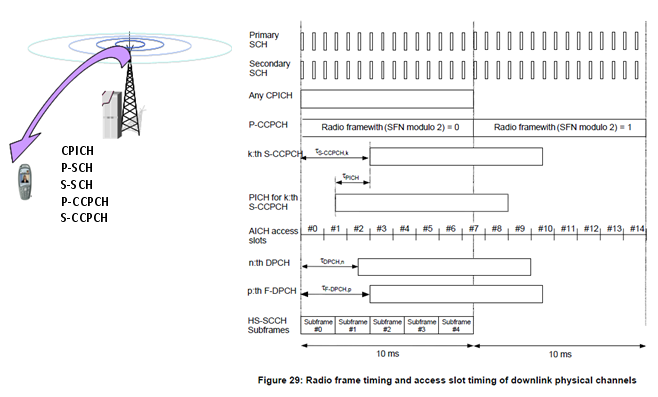Cell Search Procedure
Cell Search procecess in WCDMA would be described as follows (For the detailed understanding, I would recommend you to study each of the physical channels involved in the following description).
i) Every cell is tranmitting its scrambling code(Primary Scrambling Code) via CPICH.
ii) UE detect the cell power, primary scrambling code and some addition info for compensating demodulation process
iii) UE detect P-SCH (Primary Synchronization Code) and figure out slot boundary (start and end of each slot)
iv) UE detect S-SCH (Primary Synchronization Code) and figure out frame bounday (start and end of each frame)
v) UE detect P-CCPCH and decode MIB. Through this MIB, UE can figure out SFN.
Downlink Frame Timing
Once you complete the cell search process described above, UE can figure out the following information about the timing.
i) Exact phase reference for downlink channels from CPICH (This is not the timing parameter, but this would very important factors to decode other channels including Timing/Sync related channels).
ii) Exact start timing of each slots from P-SCH
iii) Exact start timing of each frame from S-SCH
iv) System Frame Number for each frame from P-CCPCH (MIB)
Once UE get all the information listed above, the timing for other channels can be deduced by the following diagram (This diagram came from 3GPP TS 25.211). For example, S-CCPCH is transmitted at the multiples of 256 chips delay from the start of CPICH(Start of frame timing). And PICH is transmitted at the specified timing before S-CCPCH.
For the details of these timing value, refer to 25.211 - 7 Timing relationship between physical channels - 7.1 General
Some of these timing offsets are set by higher layer signaling message (e.g, SIB, RRC Connection Setup, Radio Bearer Setup).
S-CCPCH TimingOffset is specified by SIB5 elements : sCCPCH-SystemInformationList.SCCPCH-SystemInformation[0].secondaryCCPCH-Info.modeSpecificInfo.fdd.timingOffset
Uplink Frame Timing
In R99 (WCDMA) case, the only Uplink channel you have is PRACH and DPDCH/DPCCH, but PRACH is special case which will be described in detail in 'RACH Process' section. Here we only think about DPDCH/DPCCH.
Uplink DPDCH/DPCCH timing is 1024 chips after DPDCH/DPCCH timing.
Measurement Control and Handover
I got a question long time ago, saying "Why we see measurement control/measurement report almost always in Handover procedure ?"
In real live network, it would be common to perform 'Measurement Control' both for SHO and HHO. But purely in terms of technology, 'Measurement Control' and 'Measurement Report' is not a mandatory part for any Handover process. If I explain these two procedure in a very simplified (a little bit over simplified) manner, I would say
i) Handover - Changing a communication cell from one to another, or changing the number of communication cell to one to another.
ii) Measurement Control - Ordering UE to perform a specific measurement (e.g, the signal quality of the current cell or the signal quality of another cell).
Basically these two procedures are independent.
But in reality, most of network operator combine these two process mainly to improve the successbility of the handover.
For example, let's suppose that there are two cells (let's call them Cell A, Cell B respectively) and a UE is now communicating to cell A and now your network is trying to let UE change the communication cell from Cell A to Cell B. The simplest way would be to send UE a handover command, saying "change Cell from A to B". But what if the cell B is not ready to communicate with your UE. For example, the signal quality between Cell A and UE is so bad and it will almost for sure that the call would drop as soon as the UE changes the cell ?
Do you still want to change the cell ?
The answer would be No.
Main for this kind of reason, the network try to make it sure that the target cell (the UE is handed over to) is good enough condition before trying handover. That's why in most live network log, you would see measurement control/measurement report message before the handover.
